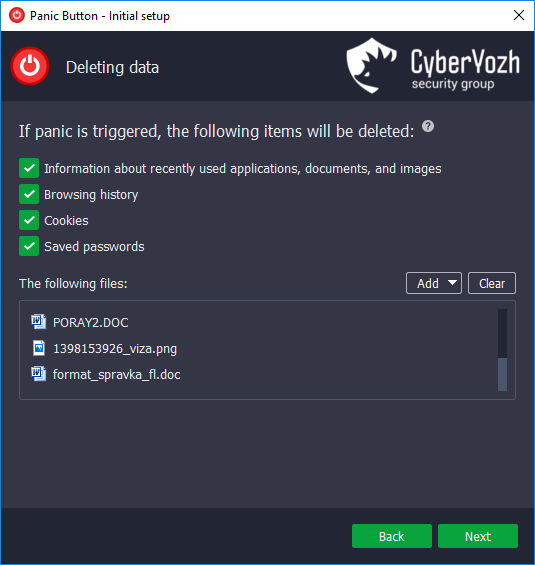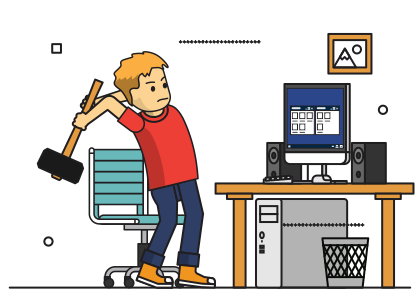You may find yourself in a situation when you need to instantly wipe all the passwords saved on your computer – in your browser, text documents, messaging clients. Perhaps, you will have only a couple of seconds for it, or you won’t have any time at all, and this is where Panic Button comes in - an emergency data erasure program.
Deleting passwords from a browser
Erasing passwords with Panic Button is extremely easy: the settings of the application offer the function of deleting passwords saved in your browser. When activated, Panic Button will securely erase all passwords to an unrecoverable state. The program destroys passwords saved in Mozilla, Chrome, Edge, Opera, and Yandex.Browser. Panic Button can’t guarantee correct performance when used on other browsers.

In addition to passwords, you can also clear the history of visited websites and saved cookies. Be aware that passwords synched to the cloud won’t be wiped and may be recovered if an attacker gets access to your cloud storage. We have already mentioned the dangers users face when storing their passwords in a cloud environment.
Deleting files with passwords
We hope that you are now storing your passwords with a password manager, however, even if you keep your passwords in a text document, the method described below will help you destroy your saved passwords in seconds.
When activated, Panic Button will unmount all mounted files with passwords, erase them (if they have been added to the emergency deletion list), clear RAM where your sensitive data may be stored otherwise and turn off the computer.
Use the program’s settings for deleting data upon activation to add your files with passwords to the deletion list. Make sure you make a backup copy and keep it in a safe place to be able to recover the deleted files without a hitch.
Tip
Make sure you make backup copies of important data and keep them in a safe place.If you keep passwords in text documents, you can add these files to the list of the files that will be deleted if the need arises. When Panic Button is activated, it will wipe all the passwords you keep on your computer.
Panic Button can also delete the information about open files and launched applications, preventing attackers from viewing what files you have opened and what applications you have run, including if you have run a password manager.
Panic Button activation. Logic bomb.
There are different ways to trigger Panic Button: you can press its icon or activate it from the tray, or you can set a hotkey combination. But there is another alternative that helps clear your passwords with Panic Button if a malicious intruder gains access to your computer – logic bomb.
Logic bomb works on the following principle: when you enter the system, you must run a file to prevent Panic Button from triggering. This is the so-called logic bomb deactivator, it can be thoroughly disguised as a document, become activated by a hotkey combination. But most importantly, an attacker who gains access to your computer won’t know about it.
An attacker enters the system triggering the countdown timer. He’s ready to pounce on your passwords and sensitive data, completely unaware that he’s set off the logic bomb that instantly destroys all your passwords and sensitive data, sending you an alert to your email address.
Tip
Set up a logic bomb, protect your sensitive data from being accessed by attackers.You can set the logic bomb in the section “Logic bomb”. It allows you to adjust the time for the logic bomb to activate, the timer that will be shown on the screen and warn the user about the impending erasure and the need to deactivate the logic bomb. You can also use a key combination to deactivate the logic bomb.

Keep your deactivation file well-hidden and use the key combination. If your deactivation is successful, you will see a notification in the tray.
